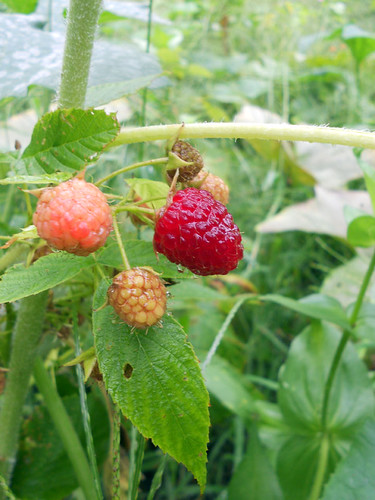So, off to Blanford Nature Center the boys and I went. We've been spending a lot of time on bikes lately, so I though "Why not, lets trek on down?" Yeah, that's a mile and a half, baby. With Torin on a Transformer's bike with training wheels. He's a very tall six year old, so the knobby knees sticking out to form acute triangles was an image to cherish. But by mile marker 1 he was whining about exhaustion, and it became less like escapism and more like work. (Fun fact of the day: Blandford is decidedly all uphill from my house, which made toting Quinny in a trailer on my shitty bent-up Huffy less fun.) But we made in tact, secured the bikes with my chain, and started stomping.
It was splendid and muddy and gloriously mosquito free. We spent time hanging out on the boardwalk through the "wetlands" (a stinky Michigan swamp if ever there was one, but we're in the city, after all) and sitting at the edge of the minor precipice behind the Center. Oh, and did you know there is such a thing as neon orange fungus? If you don't believe me, take the Blue Heron Highway trail out to the Interpretive Center. It's pretty nifty stuff.
So, what have I done the garden this past week? Nuthin. Nadda. Zilp, zitch, zero. I have glanced at the sunflowers and morning glories and other splendid morning risers on my way out the door, but I haven't actually stepped foot past the purple garden gate. Shame on me, I know, but I just haven't had the "umph".
I went on a trip to St. Louis with the boys, my sister-in-law, and two nephews last weekend, and it was decidedly taxing. I had the beginnings of a wicked cold, and all the flying around in puddle jumpers obviously didn't help the recovery process. It was only a few days ago that my head didn't feel on the verge of spontaneous combustion. So I take it on faith that the giant pumpkins are still turning orange, the sweet potatoes are getting big enough to eat, and the weeds still haven't completely snuffed out the marigolds that once so gloriously lined the charming garden pathways.
Erroneous assumptions? Lets hope not. I'm still just too damned tired to duck under the wicked grape vines that seem intent on barring passage out back. I'll check in later with some photos of lush moonvine flowers (that I don't let the boys touch) and maybe a shot of the buttery yellow butternut that is doomed to be soup some crisp Autumn afternoon soon.
Autumn. Damn.






































